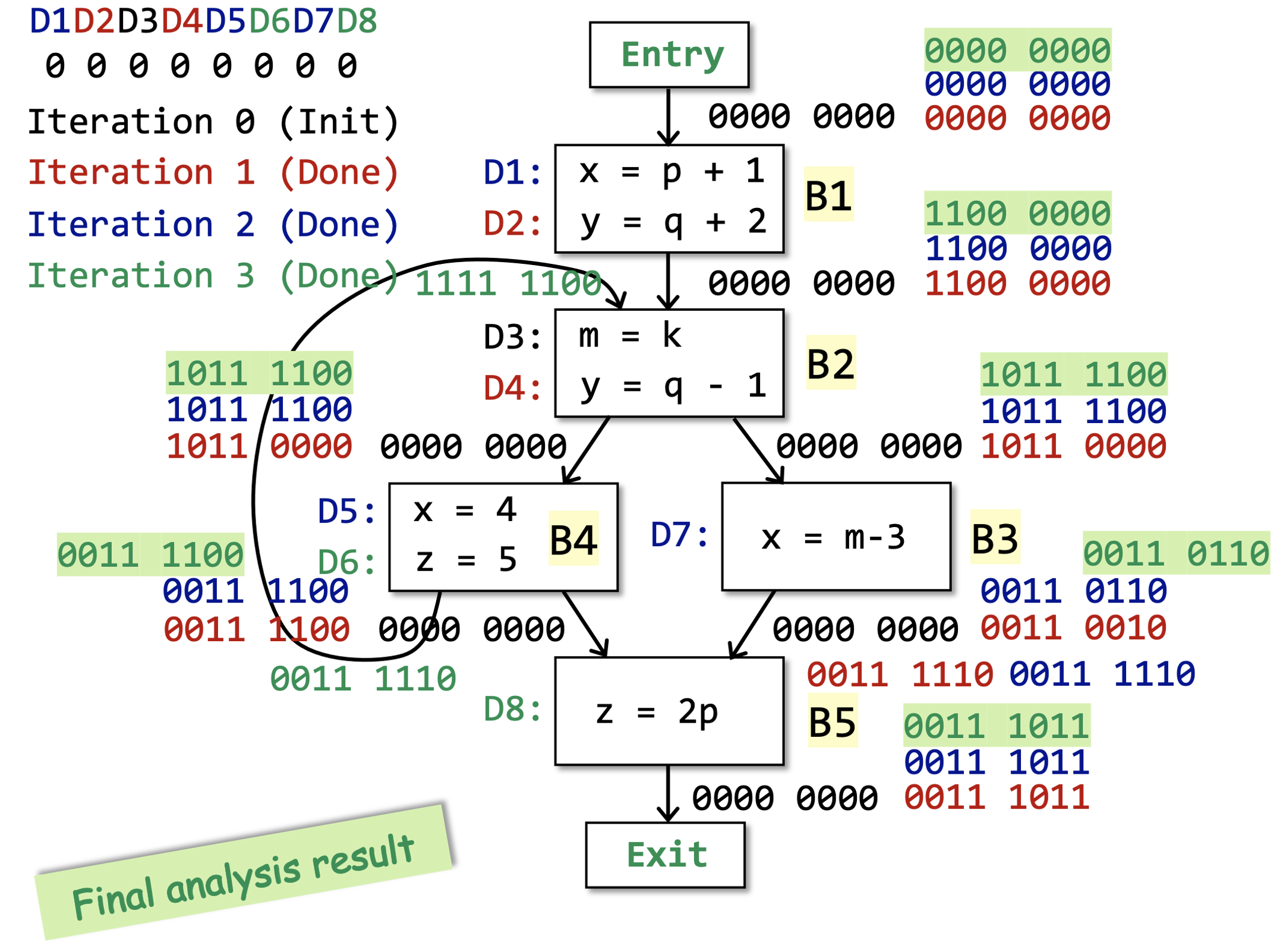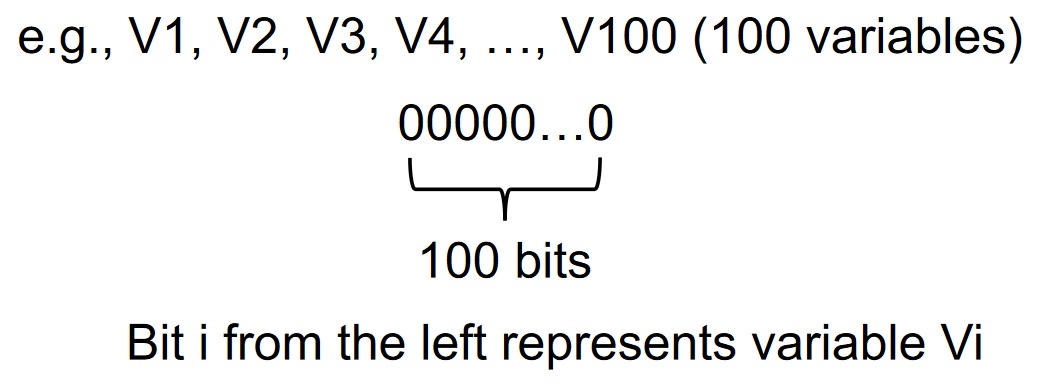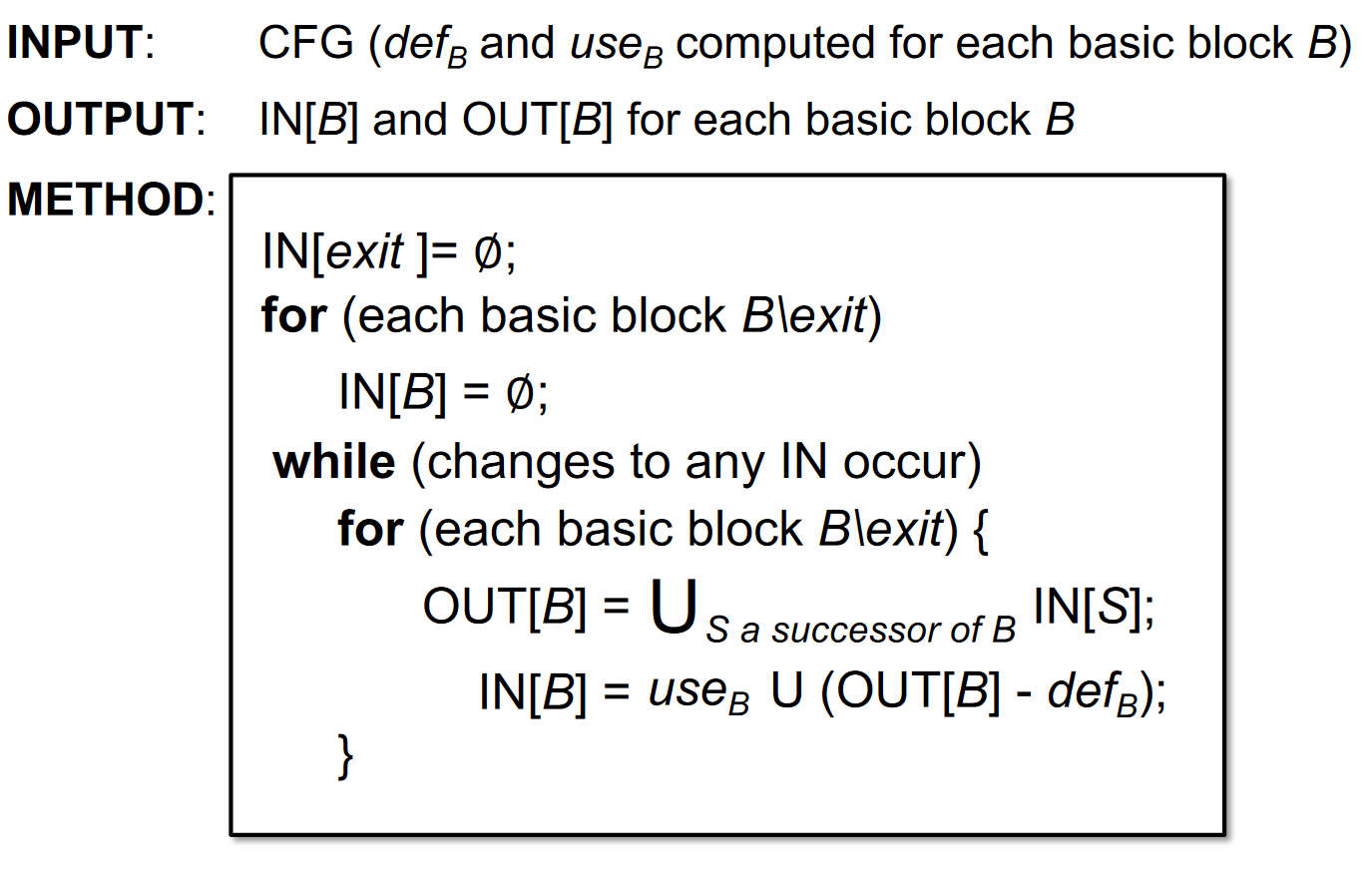Data Flow Analysis I
Overview of Data Flow Analysis
核心:how data flows on CFG? 展开: how application-specific data –> abstraction flows through the –>safe approximation nodes(BBs/statements) and –>transfer function edges(control flows) of –>control-flow handling CFG(a program)? 对于大多数静态分析来讲都是may analysis: may analysis:
- outputs information that may be true(over-approximation)
must analysis:
- outputs information that must be true(under-approximation)
Over-and under-approximations are both for safety of analysis about safe approximation : may analysis:safe = over must analysis: safe = under 不同的数据流分析,有着不同的data abstraction, flow safe-approximation策略,transfer functions&control-flow handlings。
Preliminareis of Data Flow Analysis
input and output states
- each execution of an IR statement transforms an input state to a new output state
- the input(output) state is associated with the program point before(after) the statement
 In each data-flow analysis application, we associate with every program point a data-flow value that represents an abstraction of the set of all possible program states that can be observed for that point
在数据流分析中,我们会把每一个PP关联一个数据流值,代表在该点中可观察到的抽象的程序状态。
In each data-flow analysis application, we associate with every program point a data-flow value that represents an abstraction of the set of all possible program states that can be observed for that point
在数据流分析中,我们会把每一个PP关联一个数据流值,代表在该点中可观察到的抽象的程序状态。
 data-flow analysis is to find a solution to a set of safe-approximation-directed constraints(约束规则) on the IN[s]’s and OUT[s]’s,for all statements s.
data-flow analysis is to find a solution to a set of safe-approximation-directed constraints(约束规则) on the IN[s]’s and OUT[s]’s,for all statements s.
- constraints based on semantics of statements(transfer functions)
- constraints based on the flows of control
Notations for transfer function’s constraints

Notations for control flow’s constraints(控制流约束)
 The meet operator ^ is used to summarize the contributions from different paths at the confluence of those paths
The meet operator ^ is used to summarize the contributions from different paths at the confluence of those paths
不会涉及到的概念
- 函数调用 Method Calls
- 我们将分析的是过程本身中的事情,即 Intra-procedural。而过程之间的分析,将在 Inter-procedural Analysis 中介绍
- 变量别名 Aliases
- 变量不能有别名。有关问题将在指针分析中介绍。
Reaching Definitions Analysis(定义可达性分析)
A definition d at program point p reaches a point q if there is a path from p to q such that d is not “killed” along that path
- A definition of a variable v is a statement that assigns a value to v
- Translated as: definition of variable v at program point p reaches point q if there is a path from p to q such that no new definition of v appears on that path
程序中变量 v 的一个 定义(Definition) 是指一条给 v 赋值的语句,我们称在程序点 p 处的一个定义 d 到达(Reach) 了程序点 q ,如果存在一条从 p 到 q 的“路径”(控制流),在这条路径上,定义 d 未被 覆盖(Kill) 。称分析每个程序点处能够到达的定义的过程为 定义可达性分析(Reaching Definition Analysis) 。
 Reaching definitions can be used to detect possible undefined variables. e.g., introduce a dummy definition for each variable v at the entry of CFG, and if the dummy definition of v reaches a point p where v is used, then v may be used before definition (as undefined reaches v)
到达定值可以用来分析未定义的变量。例如,我们在程序入口为各变量引入一个 dummy 定值。当程序出口的某变量定值依然为 dummy,则我们可以认为该变量未被定义。
Reaching definitions can be used to detect possible undefined variables. e.g., introduce a dummy definition for each variable v at the entry of CFG, and if the dummy definition of v reaches a point p where v is used, then v may be used before definition (as undefined reaches v)
到达定值可以用来分析未定义的变量。例如,我们在程序入口为各变量引入一个 dummy 定值。当程序出口的某变量定值依然为 dummy,则我们可以认为该变量未被定义。
understanding reaching definitions
- data flow values/facts 到达定值中的数据流值
- the definations of all the variables in a program
- can be represented by bit vectors

- D: v = x op ythis statement “generates” a definition D of variable v and “kills” all the other definitions in the program that define variable v,while leaving the remaining incoming definitions unaffected.
- transfer function

- 从入口状态删除 kill 掉的定值,并加入新生成的定值。
- v = x op y,gen v, kill 其它所有的 v
- control flow
 A definition reaches a program point as long as there exists at least one path along which the definition reaches.任何一个前驱的变量定值都表明,该变量得到了定义。
A definition reaches a program point as long as there exists at least one path along which the definition reaches.任何一个前驱的变量定值都表明,该变量得到了定义。
- transfer function
Algorithm of Reaching Definitions Analysis
 这是一个经典的迭代算法。
这是一个经典的迭代算法。
- 首先让所有BB和入口的OUT为空。因为你不知道 BB 中有哪些定值被生成。
- 当任意 OUT 发生变化,则分析出的定值可能需要继续往下流动,所需要修改各 BB 的 IN 和 OUT。
- 先处理 IN,然后再根据转移完成更新 OUT。
为什么程序能够停止?

- 一个程序中,gen和kill是固定的。在 gen U (IN - kill) 中,kill 与 gen 相关的 bit 不会因为 IN 的改变而发生改变。
- OUT不会减少。其它 bit 又是通过对前驱 OUT 取并得到的,因此其它 bit 不会发生 1 -> 0 的情况。所以,OUT 是不断增长的,而且有上界,因此算法最后必然会停止。
- 因为 OUT 没有变化,不会导致任何的 IN 发生变化,因此 OUT 不变可以作为终止条件。我们称之为程序到达了不动点(Fixed Point)
An example
 定义可达分析的结果:
定义可达分析的结果:

Live Variables Analysis
Live variables analysis tells whether the value of variable v at program point p could be used along some path in CFG starting at p.If so,v is live at p;otherwise,v is dead at p.
- 变量 x 在程序点 p 上的值是否会在某条从 p 出发的路径中使用
- 变量 x 在 p 上活跃,当 且仅存在一条从 p 开始的路径,该路径的末端使用了 x,且路径上没有对 x进行覆盖。
- 隐藏了这样一个含义:在被使用前,v 没有被重新定义过,即没有被 kill 过。
 这个算法可以用于寄存器分配,当一个变量不会再被使用,那么此变量就可以从寄存器中腾空,用于新值的存储。
注意这是一个 may analysis
这个算法可以用于寄存器分配,当一个变量不会再被使用,那么此变量就可以从寄存器中腾空,用于新值的存储。
注意这是一个 may analysis
活跃变量中的数据流值(数据抽象)
- 程序中的所有变量
- 依然可以用 bit vector 来表示,每个 bit 代表一个变量

Backward analysis
更直观,发现利用–>向前传播
Transfer function

- 一个基本块内,若 v = exp, 则 def v。若 exp = exp op v,那么 use v。一个变量要么是 use,要么是 def,根据 def 和 use 的先后顺序来决定。
- 考虑基本块 B 及其后继 S。若 S 中,变量 v 被使用,那么我们就把 v 放到 S 的 IN 中,交给 B 来分析。
- 因此对于活跃变量分析,其控制流处理是 OUT[B] = IN[S]。
- 在一个块中,若变量 v 被使用,那么我们需要添加到我们的 IN 里。而如果 v 被定义,那么在其之上的语句中,v 都是一个非活跃变量,因为没有语句再需要使用它。
- 因此对于转移方程,IN 是从 OUT 中删去重新定值的变量,然后并上使用过的变量。需要注意,如果同一个块中,变量 v 的 def 先于 use ,那么实际上效果和没有 use 是一样的。
Algorithm

- 我们不知道块中有哪些活跃变量,而且我们的目标是知道在一个块开始时哪些变量活跃,因此把 IN 初始化为空。
- 初始化的判断技巧:may analysis 是空,must analysis 是 top。
关键点:已知out去求in,先use后define
Avaliable Expressions Analysis
可用表达式分析 must analysis
基本概念
- x + y 在 p 点可用的条件:从流图入口结点到达 p 的每条路径都对 x + y 求了值,且在最后一次求值之后再没有对 x 或 y 赋值
可用表达式可以用于全局公共子表达式的计算。也就是说,如果一个表达式上次计算的值到这次仍然可用,我们就能直接利用其中值,而不用进行再次的计算。

可用表达式分析中的数据流值
- 程序中的所有表达式
- bit vector 中,一个 bit 就是一个表达式
Algorithm

- 注意此时的初始化:一开始确实无任何表达式可用,因此OUT[entry]被初始化为空集是自然的。但是,其它基本块的 OUT 被初始化为全集,这是因为当 CFG 存在环时,一个空的初始化值,会让取交集阶段直接把第一次迭代的 IN 设置成 0,无法进行正确的判定了。
- 如果一个表达式从来都不可用,那么OUT[entry]的全 0 值会通过交操作将其置为 0,因此不用担心初始化为全 1 会否导致算法不正确。
举例

Conlusion

划重点
- 三种数据流分析
- 到达定值
- 活跃变量
- 可用表达式
- 三种数据流分析的区别和联系
- 知道迭代算法,以及算法能停机的原因